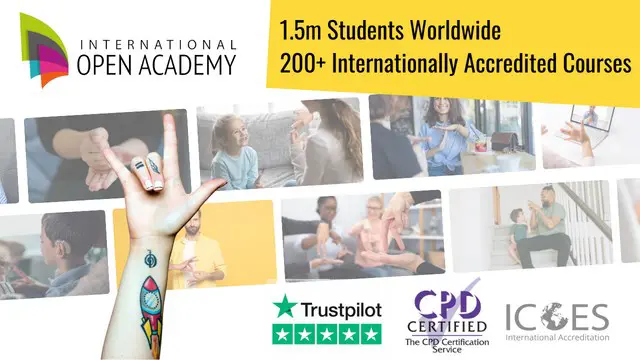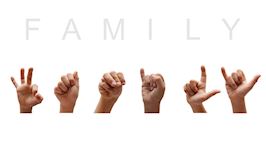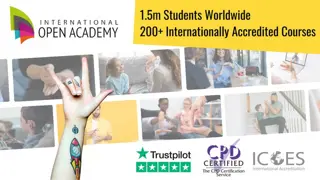
American Sign Language Course
CPD UK Certified | ICOES International Accreditation | 50 CPD Points | Certification Available| Free Retake Exam
International Open Academy
Summary
Add to basket or enquire
Overview
Give your brain a boost by learning another language and break down communication barriers between you and millions of ASL users
Did you know there are as many as 500,000 native ASL speakers? And up to 2 million who have learnt ASL as a second or subsequent language? You can be the next!
American sign language is a thriving language, separate from English, used throughout the U.S., Canada, Africa, and some other parts of the world. Learning ASL allows you to communicate with any of these people, in any situation.
There are many social, cultural and professional reasons to learn sign language, including:
- becoming part of the ASL community. You’ll be able to reach out and connect with people who are deaf and hard of hearing either socially or professionally
- communicating with a new friend at school, relative or neighbor who is deaf
- learning about deaf culture and community
- expressing yourself through body language and not just words
- learning a language is great exercise for the brain
- interpreting the signals between coaches and players at major sports’ events (see how they use sign rather than shouting?)
KEY COURSE BENEFITS:
• Course access: 60 days – Study at your own pace
• Internationally-recognized CPD accredited course
• Start learning straightaway from any laptop or mobile device in any country
CPD
Course media
Description
Whether you're seeking self-improvement and personal growth, work with the deaf community, or have friends or family members who are either deaf or are losing their hearing, learning American Sign Language, or ASL, can be immensely valuable to you. In addition to improving your skillset and learning a new language, you will learn how to use your body language and facial expressions to communicate, which can benefit you in every walk of life, including vocal communication.
Learning sign language is a great way to give back to your community by allowing you to communicate with deaf members of your neighborhood. It also allows you to facilitate communication in multiple fields, and can be highly beneficial for teachers, persons working in customer service and sales, and for those working with children in any capacity.
More than 5% of the world population has hearing loss, including 11 million in the USA, according to the World Health Organization. Therefore, anyone who deals with the public - from shop assistants to social workers - will benefit from knowing ASL.
You can begin now by following the demonstrations and videos in our ASL online course.
This ASL course will walk you through the fundamentals of sign language with interactive video lessons to teach you how to begin communicating with the deaf community. You will learn the most important signs to get you started, fingerspelling, grammar, theory, and much more, so that when you complete this course, you will be able to ask questions, chat, and you will have a strong base for easily learning more signs.
Because there are several thousand signs in ASL, this course is designed to give you a strong understanding of the fundamentals you need to communicate in ASL, rather than giving you a dictionary of every sign available.
This will allow you to master what you need to begin communication, and then move on to increasing your vocabulary at your own pace.
The Basics – Learn the alphabet, numbers, fingerspelling, introductions, greetings, and names, so that you can introduce yourself, and get a conversation started.
Questions – Learn how to ask questions, how to phrase them, and how to ask about objects when you don't know the sign.
Work & Education – You will learn how to make appointments, ask the time, travel, use work titles, and much more.
Conversations – Learn how to talk about friends and family, how to use expressions to convey what you mean, how to ask questions and make statements, and how to describe actions and objects. This will allow you to have conversations about people, places, and things.
Theory – Master the fundamentals of grammar, structure, and rules to ensure that you have a good base for learning and speaking ASL.
Etiquette – You will walk away with an understanding of deaf etiquette, so that you can approach any situation as politely and appropriately as possible.
It’s not just about the signs. With ASL, you use facial expressions and body language to convey meaning.
Access duration
The content will be accessible to you 24/7. You can keep the course forever so you can refresh your memory from time to time.
How is the course assessed?
There is a short multiple choice exam at the end of each module for you to take, You’ll know your score immediately and there's no extra fee for sitting an exam or have to wait for a set date to sit an exam.
American Sign Language Course Breakdown
Module 1: The Basics
- 1.1 What is ASL
- 1.2 Alphabet
- 1.3 Who Uses ASL
- 1.4 A Quick History of ASL
- 1.5 Getting Started
Module 2: Numbers, Parameters and Grammar
- 2.1 Numbers
- 2.2 Parameters
- 2.3. Grammar and Structure
Module 3: Introductions
- 3.1 Introduction Vocabulary
- 3.2 Name Sign
- 3.3 Deaf Etiquette
- 3.4 Facial Expressions
Module 4: People & Places, Gender and Body Language
- 4.1 People and Places Vocabulary
- 4.2 Gender Distinction
- 4.3 Using Body Language
Module 5: Conversation I
- 5.1 Conversational Vocabulary
- 5.2 Is ASL Universal
- 5.3 Questions Vs. Statements
- 5.4 Phonology in ASL
Module 6: Job & Education, Lexicalized Signs and Morphology
- 6.1 Job/Education Vocabulary
- 6.2 Lexicalized Signs
- 6.3 Morphology in ASL
Module 7: Descriptions, Classifiers and Syntax
- 7.1 Descriptions Vocabulary
- 7.2 Classifiers
- 7.3 ASL Syntax
Module 8: Conversation II
- 8.1 Making Plans Vocabulary
- 8.2 Number Incorporation
- 8.3 Expressive Sentences
- 8.4 Variations in ASL
- 8.5 Improving Your Vocabulary
Who is this course for?
This course is ideal for anyone who wants to get started with American Sign Language to enhance their communication skills.
With in-depth video tutorials and lessons, explanations of theory and usage, and a format that allows you to study at your own pace, this course is designed to make learning ASL as easy and as friendly as possible. Even if you're not planning to use ASL right away, learning it can be beneficial to you, your career, and your communication skills.
This course is ideal for everyone who:
- wants to learn a language used by millions of people
- is looking to be more visual in their speech or during presentations
- seeks ways to use their body language and facial expressions as well as their voice to communicate
- interacts with the public and wants to be able to reach out to the deaf community
- teaches and may have pupils who are deaf or hard of hearing
- has family or friends who uses ASL
- has ageing parents or friends who are losing their hearing and will need to learn sign
- is getting older, feels their hearing is getting worse and wants to learn to sign
- works as a first responder who needs to communicate with everybody, particularly in emergencies
- has ambitions to continue their education in ASL, towards becoming fully fluent
- is exploring the many careers that involve working with and assisting the deaf community
- wants to be better able to communicate with friends, family, and coworkers who are deaf
- has an interest in different cultures
- has or interacts with young children - pre-verbal tots can communicate well through sign language
- is interested in interpreting in the classroom, government agencies, museums, hospitals or on TV
Reserve your place in our crash course in ASL to get started with one of the most vibrant and interactive languages in America.
Learn through interactive video hosted by a licensed ASL teacher, and study at your own pace to master the signs you need to communicate with others. All of our courses are backed by a full 14-day guarantee and accredited by the International Council for Online Education Standards.
Requirements
This American Sign Language course is open to all, with no formal entry requirements.
Career path
After completing this course, you could:
- Continue your education in ASL, towards becoming fully fluent
- Explore the many careers that involve working with and assisting the deaf community
- Be better able to communicate with deaf friends, family, and coworkers
Questions and answers
I live in UK, hopefully moving to USA in next 3 years, will this certificate be recognised to a new employer in the States please?
Answer:Hi Anna, Thank you for your query. Our courses are accredited by ICOES and CPD Certification Service, meaning that the course counts towards the individuals' CPD hour records. I invite you to have a look at the course syllabus on REED to learn more about its content and the opportunities it opens. Kind regards, IOA Team
This was helpful.
Reviews
Legal information
This course is advertised on reed.co.uk by the Course Provider, whose terms and conditions apply. Purchases are made directly from the Course Provider, and as such, content and materials are supplied by the Course Provider directly. Reed is acting as agent and not reseller in relation to this course. Reed's only responsibility is to facilitate your payment for the course. It is your responsibility to review and agree to the Course Provider's terms and conditions and satisfy yourself as to the suitability of the course you intend to purchase. Reed will not have any responsibility for the content of the course and/or associated materials.






